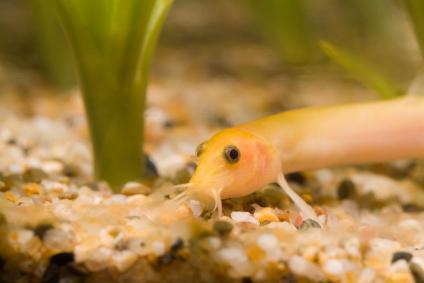Weather Loach (Dojo)

The weather loach (Misgurnus anguillicaudatus) is so named because of its sensitivity to changes in barometric pressure. Weather loaches become very active right before a thunderstorm when the barometric pressure drops. This drop in barometric pressure causes a pressure change in their swim bladder.
Because of this, the weather loach is said to be able to "predict" the weather.
The weather loach also goes by other names:
- dojo
- Chinese weather loach
- Japanese weather loach
- weatherfish
Weather loaches belong to the family Cobitidae, which includes the more well known Kuhli loach. There are 2 color varieties of weather loaches - the common weather loach, which is brownish in color and has spots, and the golden weather loach shown in the photo above.
Weather loaches are from Asia. They are peaceful, bottom-dwelling fish. They are most active at night and right before a thunderstorm. It is a good idea to have plants and rocks in their tank for them to hide in during the day. Providing caves for them is best and it is also a good idea to provide some rocks with flat surfaces in their tank. Make sure the substrate has no sharp edges because weather loaches like to dig in it. Having fine substrate in your weather loach tank is best because it makes it easier for them to dig in.
They are omnivores and will eat a variety of aquarium fare: flakes, sinking pellets (because they are bottom feeders), frozen, freeze-dried, and live foods.
Weather loaches are cold water fish and prefer a much cooler water temperature than most other fish and so keep this in mind when choosing their tankmates. Weather loaches do best with a water temperature that doesn't go above 70 °F (22 °C). If you keep weather loaches at tropical temperatures it shortens their life span. They can tolerate even lower temperatures (50 °F or 10 °C).
Weather loaches do best with a neutral pH and in medium-hard water. You should keep at least 4 weather loaches together in your tank. They don't do well without the company of other fish of their species.
They reach a size of about 8 inches (20 cm) in length.
They are egglaying fish, but rarely spawn in the aquarium. When they do spawn they scatter their eggs among plants. The pectoral fins are larger on the males than the females. The pectoral fins are the paired fins that are on both sides of the fish right behind the gill covers. It has been suggested that keeping the water temperature in the tank cooler and then warming it up a little may help induce spawning.
